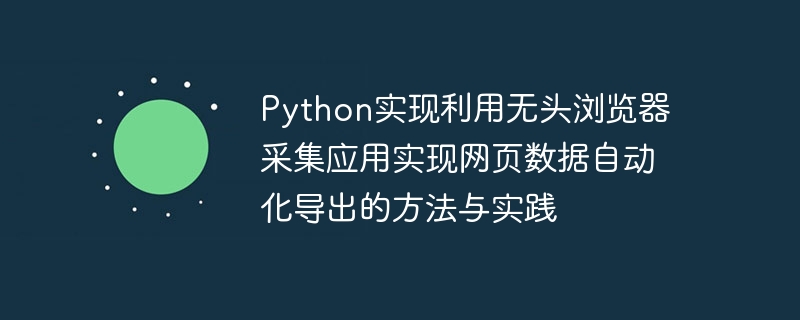

Python implements methods and practices for automatically exporting web page data using headless browser collection applications
1. Introduction
Nowadays, Internet information is growing explosively. A large amount of data is stored on various web pages. In order to extract, analyze and process this data, we need to use crawler tools to achieve data collection. The method of using a headless browser to automatically export web page data has become a very effective way. This article will introduce how to implement this method using Python and give code examples.
2. Headless Browser
Headless browser is a browser that has no graphical interface and can be operated automatically. Unlike traditional browsers, headless browsers can run in the background without user interaction. It simulates users using a browser to open a web page, fill in a form, click a button and other operations, so that the data on the web page can be easily obtained.
Currently popular headless browsers include Selenium, PhantomJS and Headless Chrome. This article will use Selenium as an example to explain.
3. Installation and Configuration
First, we need to install the Selenium library and the corresponding browser driver. Run the following command in the command line to install Selenium:
pip install selenium
Before using Selenium, you also need to download and configure the corresponding browser driver. For example, if you want to use the Chrome browser, you can download the driver that matches your Chrome version from the Chrome official website and add the driver file to the system path. In this way, Selenium can automatically call the browser to perform page operations.
4. Code Example
The following is a simple example to illustrate how to use Selenium for headless browser collection application:
# 导入所需的库 from selenium import webdriver from selenium.webdriver.chrome.options import Options # 创建浏览器对象 options = Options() options.add_argument('--headless') # 无头模式 driver = webdriver.Chrome(chrome_options=options) # 打开网页 driver.get('http://example.com') # 获取页面上的数据 title = driver.title content = driver.find_element_by_css_selector('.content').text # 打印数据 print('标题:', title) print('内容:', content) # 关闭浏览器 driver.quit()
In the above code, all the required libraries. Then we created a browser object and enabled headless mode. Next, open the web page through thegetmethod. You can get the web page title through thetitleattribute, get the element of the specified CSS selector through thefind_element_by_css_selectormethod, and pass thetextAttribute gets the text content of the element.
Finally, print out the obtained data through theprintstatement, and close the browser through thequitmethod.
5. Practical Application
The method of using a headless browser to collect applications can be widely used in the automated export of web page data. In practical applications, we can write scripts to automatically collect data at regular intervals, thus eliminating tedious operations such as manual copying and pasting.
For example, we can encapsulate the above sample code into a function and write a loop to automatically access web pages and export data at regular intervals. We can also combine other functions, such as using a database to store data, using emails to send data, etc. In this way, we can implement a complete automated web page data export system.
In practical applications, it is important to abide by the website usage rules and not affect the normal operation of the website. At the same time, you should also note that changes in the web page structure may cause the script to become invalid, and the code needs to be adjusted in time to adapt to the new page structure.
6. Summary
This article introduces the methods and practices of using headless browser collection applications to automatically export web page data. By using Python's Selenium library, we can easily realize the function of automatically collecting web page data, and can expand and customize it according to actual needs. By rationally applying headless browser collection applications, we can improve the efficiency of data collection and save a lot of human resources. Hope this article is helpful to everyone.
The above is the detailed content of Python implements methods and practices for automatically exporting web page data using headless browser collection applications. For more information, please follow other related articles on the PHP Chinese website!




